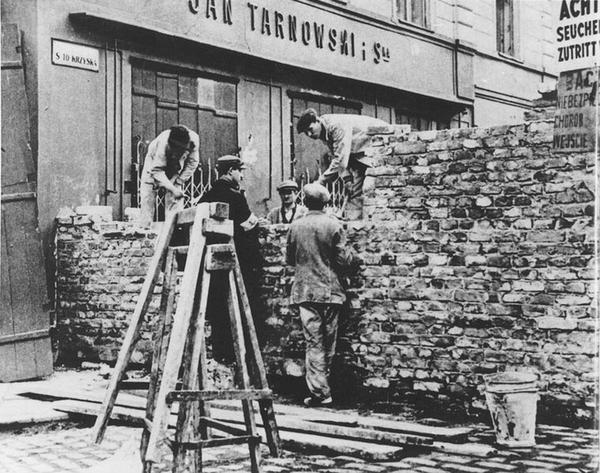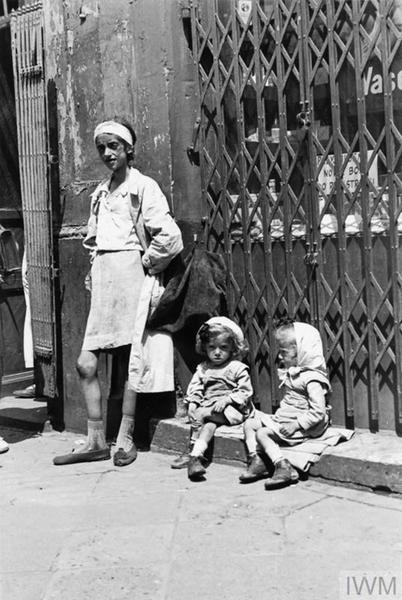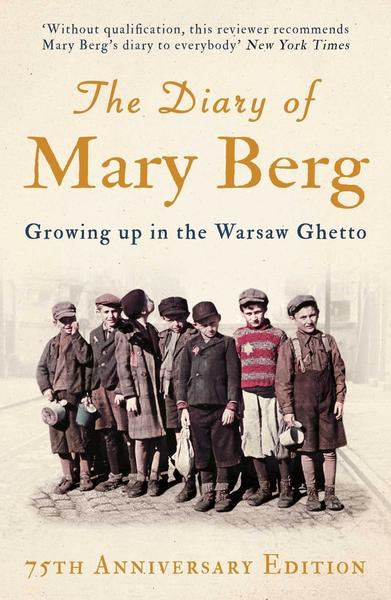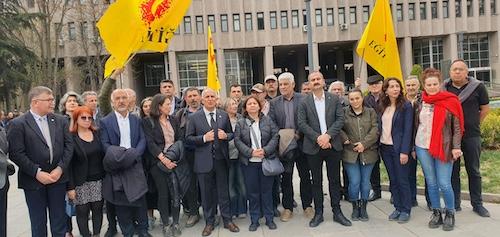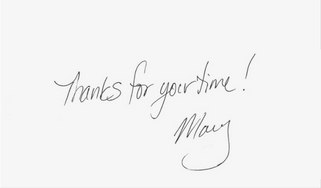April 18, 2025 Hello , In May 1944, while Anne Frank remains in hiding in Amsterdam writing her diary, another Jewish girl's Holocaust diary is serialized in American newspapers. It's published under the pen name Mary Berg to protect any surviving relatives in Europe. This American teenager's diary becomes one of the earliest firsthand accounts in English telling of Nazi genocide. The following year three months
before D-Day, Mary's diary is published as a book detailing the starvation and wholesale slaughter of Jews in Poland. In the following decades, Anne Frank's diary is read by teenagers across America, published in 50 languages it becomes one of the most popular books in the world. Mary Berg's diary slips into the cracks of history, her name briefly remembered by a few.
An American Girl's Holocaust Diary
Miriam Wattenberg wrote her diary while trapped in the Warsaw ghetto, where she survived two years before her American passport became a ticket to freedom. When the Nazi's released her and she arrived safely in America, she believed her story could save thousands of Jews in Europe from dying in the gas chambers.
2006 edition of Miriam's diary. She changed her name to
protect relatives in Europe. Miriam was fifteen when Germany invaded Poland in the autumn of 1939. She lived Lodz with her Polish father, American mother and younger sister Anna. When German soldiers neared the city, the family fled, walking and bicycling seventy miles to Warsaw in
hopes of safety. The moved into an apartment in the Jewish neighborhood and for awhile, hanging an American flag on their door kept them safe. Then, by one decree after another, the Nazi's tighten the rope around Warsaw's Jews. It happened over time, the star of David on their sleeve, the synagogues closed, the 5pm curfew, men snatched off the street and deported, women forced to clean house for the
SS. Miriam's mother Lena, applied for American passports for the family but when the documents were ready, it no longer mattered. A new decree had been issued forbidding Jews from Warsaw to leave. And then the walls went up. "Jewish masons, supervised by Nazi soldiers, are laying bricks upon bricks." Miriam wrote in her spiral bound notebook. "Those who do not work fast enough are lashed by the overseers. It makes me think of the Biblical description of our slavery in Egypt. But where is the Moses who will release us from our new bondage?”
The Wall of ghetto in Warsaw - Building on Nazi-German order August 1940. Public Domain In the ghetto, life went on. Adults went to their jobs in the quarter, relatives married and babies were born. Miriam worked toward a graphic arts degree, visited with her friends in at the café and enjoyed musical and theatrical entertainment.
Miriam (18) in the Warsaw Ghetto with her boyfriend Romek Kowalski,
1942, United States Holocaust Memorial Museum, courtesy of Mary Berg. But life soon left all normalcy behind as food grew short and disease spread and the pages of Miriam's diary filled with start descriptions of “Sometimes a child huddles against his mother, thinking that she is asleep and trying to awaken her, while, in fact, she is
dead. In June 1942, she writes words of frustration and anger. “Where are you foreign correspondents? Why don’t you
come here and describe the sensational scenes in the ghetto? No doubt you don’t want to spoil your appetite. Or are you satisfied with what the Nazis tell you – that they locked up the Jews in the ghetto to protect the Aryan population from epidemics and dirt?”
Warsaw ghetto 1940. Photo courtesy Imperial War Museums, Willi Georg / Heinrich Joest / Mariusz Gasior. Then Miriam's family gets word the Nazis will allow Jews with foreign passports to leave. Dare she hope this nightmare will come to an end? At this same time, in another city occupied from the Nazi's half a continent away, Anne Frank receives a diary for her thirteenth birthday. A month later the Frank family goes into hiding in the Secret Annex.
Miriam and her family remain in captivity in the the ghetto, but are removed from the general population and detained at the infamous Pawiak Prison, for a brief while, according to German officials. Eighty foreign Jews are locked up and Miriam shared a cell with eleven Americans. “Today, I boldly removed my armband,” she wrote. “After all, officially I am now an American citizen.” But the prison was located near the center of the ghetto overlooking the Umschlagplatz and there lay the railroad tracks. Beyond the prison windows, every day July through mid-August Nazis loaded ten thousand people on trains and sent them east to death at Treblinka. “We are here as on an island amidst an ocean of blood,” Miriam wrote. “The whole ghetto is drowning in blood. We literally see fresh human blood; we can smell it. Does the outside world know anything
about it? Why does no one come to our aid? I cannot go on living; my strength is exhausted. How long are we going to be kept here to witness all this?” She felt the waiting was “worse than death.”
Miriam Wattenberg (Mary Berg), 1924-2013 Despite starvation
rations in the prison, Miriam survived. In late September, when her mother was nearly too weak to walk, the Nazis released the foreign Jews in Pawiak Prison and they boarded a train to an internment camp in Vittel, France. It was heaven compared to the ghetto. Miriam confided to her diary, now nearly a dozen spiral notebooks, that she stayed in bed for three days because she “couldn’t get enough of the pleasure of lying in the clean sheets.” Miriam heard they were to be exchanged for German prisoners of war, but a year passed in Vittel before she, her sister and her parents finally sailed to the United States. They arrived in New York harbor on the S.S. Gripsholm in mid-March 1944. At that
time, Anne Frank remained hiding in Amsterdam writing her diary.
Pages in Anne Frank's diary. Shortly after the Wattenberg family arrived in America, a Polish Journalist helped Miriam
get her story out to the public. A serial of Mary Berg's diary ran in May 1944, in Yiddish, English, and German language newspapers in America. “I shall do everything I can to save those who can still be saved,” Mary wrote. “I will tell, I will tell everything, about our sufferings and our struggles and the slaughter of our dearest, and I will demand punishment for the
[Germans]…who enjoyed the fruits of murder…." Between May 15 and July 9, 1944, became the deadliest period at Auschwitz-Birkenau, with Nazis sent 330,000 Hungarian men, women and children to die in the gas chambers. In September, Anne Frank and her family were arrested and transported to Auschwitz-Birkenau, her diary kept safe by a neighbor. The next year, in February 1945, The Diary of Mary Berg: Growing up in the Warsaw Ghetto...is published in English, gaining praise by the Saturday Review,
The New Yorker and New York Times Book Review. Miriam now famous in New York as Mary Berg marched on City Hall with signs demanding action to save Jews still alive in Poland. She spoke live to audience and gave interviews on the radio to publicize what would become known as the Holocaust. Meanwhile, Anne Frank is transferred to Bergen Belsen concentration camp and in March 1945, she dies of typhus. In the time Miriam had been safe in America, little more than a year, from May 1944 to August
1945 the Nazi's murdered some 500,000 Hungarian Jews. Mary Berg's diary came out in five languages, but went out of print in the early 1950's around the time Anne
Frank's diary was published in English. Mary disappeared from public life, her diary never approaching the fame of Anne Frank's. Why?
Lawrence Langer, author of the landmark study Holocaust Testimonies: The Ruins of Memory has a theory: “Anne Frank’s diary was and is more popular because it records no horrors; the horrors came after she stopped writing, so readers don’t have to confront anything painful.” Miriam Wattenberg witnessed the atrocities in the Warsaw ghetto, her diary made real to readers the suffering and violence. And she had even more to say decades later when researcher Susan Lee Pentlin tried to contact her before re-issuing Mary Berg's book in
2006.
Mary Berg refused an interview, but sent a written statement through a relative. “Instead of continuing to milk the Jewish
Holocaust to its limits,” she wrote, “do go and make a difference in all those Holocausts taking place right now in Bosnia or Chechin….Don’t tell me this is different.” Why don’t you organize conferences in memory of the Armenians or Kurds or Rwandans? By teaching about the Holocaust you’ll stop its occurrence in the future, right? But the future is
now. When the Jews were victimized, they wanted the world to save them. Are the Israelis dropping bombs on the Serbs to save Bosnian Moslems? Don’t tell me this is different." Mary Berg died in York, Pa. in 2013. If she were alive today, it's not hard to imagine what she'd have to say to us.
Like my
article today? Forward this email to share with family and friends.
https://www.bbc.co.uk/annefrank/timeline.shtml
This week from LabourStart, a source of news I've followed for many years. Türkiye: Solidarity with the teachers defending democracy The Erdoğan government in Türkiye has become increasingly authoritarian, jailing opponents and using violence and intimidation in its crackdown on dissent. As part of this process, the Turkish government has now placed the entire Executive Board of the teachers' union under house arrest.
Teachers Union members in Turkey, photo courtesy of LabourStart. | As the Education International (EI) reported: "Almost 2,000 people, including students, journalists, and lawyers, have also been detained. While independent unions in Türkiye have been facing considerable pressure from Erdoğan's increasingly authoritarian regime, this latest attack marks a significant escalation and highlights the distressing erosion
of democracy and rights in the country." At the request of EI and the education union Eğitim Sen, LabourStart has now launched a major campaign to put
pressure on the Turkish government demanding a lifting of all restrictions on union rights and the dropping of charges against union leaders. Please sign the protest letter to support the teachers here. |
Follow me on social media
This newsletter is a reader-supported publication. To support my work, consider becoming a paid subscriber.
Read
a great book? Have a burning question? Let me know. If you know someone who might enjoy my newsletter or books, please forward this e-mail. I will never spam you or sell your email address, you can unsubscribe anytime at the link below. To find out more about my books, how I help students, teachers, librarians and writers visit my website at www.MaryCronkFarrell.com. Contact me at MaryCronkFarrell@gmail.com. Click here to subscribe to this newsletter. |
|
|


